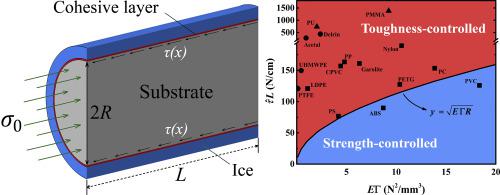Cold Regions Science and Technology ( IF 3.8 ) Pub Date : 2021-01-04 , DOI: 10.1016/j.coldregions.2020.103219 Kamran Alasvand Zarasvand , Majid Mohseni , Kevin Golovin

|
Ice accretion remains an unsolved challenge in many industrial and residential applications. The iced area can vary from ~1 cm2 to many square meters depending on the situation, and this directly affects the ice debonding mechanism. The fracture of short interfaces is controlled by interfacial shear strength, whereas interfacial toughness dominates the fracture of longer interfaces. The transition from strength-controlled to toughness-controlled fracture occurs at a critical interfacial length. Here we study the fracture mechanics and debonding of ice from several polymeric materials evaluated by the common Zero-Degree Cone Test (ZDCT). Cohesive zone analyses assuming Dugdale-type and linear cohesive laws are performed in cylindrical coordinates. For most materials, the calculated critical length is smaller than the actual interfacial length previously used in the ZDCT, indicating that ice detachment was controlled by interfacial toughness. Good agreement was observed between the values of interfacial toughness calculated in the present study and those reported in the literature. From the data, lower bounds for the ice adhesion strengths are estimated based on the actual length of ice. Our analysis indicates that the prior fracture stresses measured using the ZDCT were not the material's ice adhesion strength, but rather the asymptotic detachment load per interfacial area. Overall, the zero-degree cone test should not be used to measure the ice adhesion strength with its prior or current dimensions, but is an excellent tool for characterizing the interfacial toughness between ice and a material.
中文翻译:

圆柱冰附着力的粘性区分析:确定界面韧性或强度控制断裂
在许多工业和住宅应用中,积冰仍然是尚未解决的挑战。结冰的区域可能在〜1 cm 2之间变化视情况而定到许多平方米,这直接影响了冰的解粘机制。短界面的断裂由界面剪切强度控制,而界面韧性主导较长界面的断裂。从强度控制的断裂到韧性控制的断裂发生在临界界面长度处。在这里,我们研究了通过几种零度锥度试验(ZDCT)评估的几种聚合物材料的断裂力学和冰的剥离。假设在圆柱坐标系中进行了Dugdale型和线性内聚定律的内聚区分析。对于大多数材料,计算出的临界长度小于以前在ZDCT中使用的实际界面长度,这表明冰的脱离受界面韧性控制。在本研究中计算出的界面韧性值与文献报道的值之间观察到良好的一致性。根据数据,根据冰的实际长度估算出冰附着强度的下限。我们的分析表明,使用ZDCT测量的先前断裂应力不是材料的冰粘附强度,而是每个界面区域的渐近脱离负荷。总体而言,零度圆锥试验不应用于测量其先前或当前尺寸的冰粘附强度,而是用于表征冰与材料之间的界面韧性的出色工具。冰附着强度的下限是根据冰的实际长度估算的。我们的分析表明,使用ZDCT测量的先前断裂应力不是材料的冰粘附强度,而是每个界面区域的渐近脱离负荷。总体而言,零度圆锥试验不应用于测量其先前或当前尺寸的冰粘附强度,而是用于表征冰与材料之间的界面韧性的出色工具。冰附着强度的下限是根据冰的实际长度估算的。我们的分析表明,使用ZDCT测量的先前断裂应力不是材料的冰粘附强度,而是每个界面区域的渐近脱离负荷。总体而言,零度圆锥试验不应用于测量其先前或当前尺寸的冰粘附强度,而是用于表征冰与材料之间的界面韧性的出色工具。











































 京公网安备 11010802027423号
京公网安备 11010802027423号